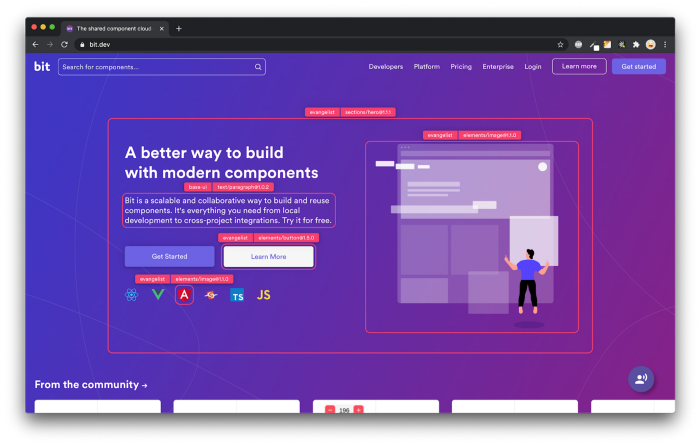This content originally appeared on Bits and Pieces - Medium and was authored by Deepanshu Tiwari
The key design principles and best practices to keep in mind while designing an Angular application.

Angular is a popular JavaScript framework used for developing dynamic, scalable and single-page applications.
To ensure the success of an Angular project, it’s important to follow best practices while designing the application.
In this article, we’ll discuss the key design principles and best practices to keep in mind while designing an Angular application.
1. Modular Design
Modular design refers to breaking down the application into smaller, self-contained modules. Each module should have its own responsibility, such as handling user authentication, managing data, or handling the display of data. This approach helps to keep the code organized and maintainable, making it easier to debug and update in the future.
// define module for authentication
@NgModule({
declarations: [AuthComponent],
imports: [CommonModule, AuthRoutingModule],
providers: [AuthService]
})
export class AuthModule {}
// define module for data management
@NgModule({
declarations: [DataComponent],
imports: [CommonModule, DataRoutingModule],
providers: [DataService]
})
export class DataModule {}
// define main application module
@NgModule({
imports: [BrowserModule, AuthModule, DataModule],
bootstrap: [AppComponent]
})
export class AppModule {}
2. Lazy Loading
Lazy loading is a technique where the application only loads components that are required for the current view, reducing the initial load time and improving the performance of the application. In Angular, lazy loading can be implemented using the Angular Router. To enable lazy loading, you need to use the loadChildren property in the route configuration.
// define lazy loaded route
const routes: Routes = [
{ path: '', component: HomeComponent },
{
path: 'lazy',
loadChildren: () => import('./lazy/lazy.module').then(m => m.LazyModule)
}
];
// define routing module
@NgModule({
imports: [RouterModule.forRoot(routes)],
exports: [RouterModule]
})
export class AppRoutingModule {}
3. Use of Reactive Forms
Reactive forms are a powerful tool for building dynamic and complex forms in Angular. They allow you to create forms with a reactive model, where changes to the form are automatically reflected in the model. This makes it easier to handle form validation, error handling, and data management.
// define form model
this.form = this.formBuilder.group({
name: ['', Validators.required],
email: ['', [Validators.required, Validators.email]]
});
// handle form submission
onSubmit() {
if (this.form.valid) {
console.log(this.form.value);
}
}
4. Utilize Angular Services
Angular services are singleton objects that can be used to share data and logic across different components in the application. They are a great way to keep the code organized and maintainable, as well as improving performance by avoiding data duplication. When designing an Angular application, it’s important to use services to encapsulate business logic and share data between components.
// define data service
@Injectable({
providedIn: 'root'
})
export class DataService {
private data = [];
getData() {
return this.data;
}
setData(data) {
this.data = data;
}
}
// use data service in component
constructor(private dataService: DataService) {}
ngOnInit() {
this.data = this.dataService.getData();
}
5. Component Design
Components are the building blocks of an Angular application and they should be designed in a way that they are reusable and maintainable.
A component should only contain the logic and data required to perform a specific task and should not be overly complex. Tools such as Bit can help you to enforce this.
Additionally, components should be designed with a clear API, making it easy for other components to interact with them.
// define component
@Component({
selector: 'app-data',
template: `
<h2>Data Component</h2>
<p>{{data}}</p>
`
})
export class DataComponent {
data: any;
constructor(private dataService: DataService) {}
ngOnInit() {
this.data = this.dataService.getData();
}
}
6. State Management
Managing state in an Angular application can be challenging, especially in large-scale applications. To avoid complexity and improve performance, it’s important to use a state management library, such as NgRx, to handle the state of the application. This helps to keep the code organized and maintainable, making it easier to update and debug in the future.
// define action
export const loadData = createAction('[Data] Load Data');
// define state
export interface DataState {
data: any[];
}
const initialState: DataState = {
data: []
};
// define reducer
export const dataReducer = createReducer(
initialState,
on(loadData, (state, { data }) => ({ ...state, data }))
);
// use store in
7. Use of Directives
Directives in Angular allow you to manipulate the DOM and extend the behavior of HTML elements. They are a powerful tool for adding dynamic behavior to your application and should be used judiciously. When designing an Angular application, it’s important to use directives to handle complex logic and data manipulation, rather than using inline code in the template.
// define custom directive
@Directive({
selector: '[appHighlight]'
})
export class HighlightDirective implements OnInit {
@Input() appHighlight: string;
constructor(private el: ElementRef) {}
ngOnInit() {
this.el.nativeElement.style.backgroundColor = this.appHighlight;
}
}
// use directive in component
<p appHighlight="yellow">Highlight me!</p>
8. Use of Pipes
Pipes in Angular allow you to format data in the template and are a great way to keep the code clean and maintainable. When designing an Angular application, it’s important to use pipes to format data, rather than using complex logic in the template. This helps to keep the code organized and improve performance, as pipes are optimized for performance.
// define custom pipe
@Pipe({
name: 'titleCase'
})
export class TitleCasePipe implements PipeTransform {
transform(value: string): string {
if (!value) {
return '';
}
return value.replace(/\w\S*/g, txt => txt.charAt(0).toUpperCase() + txt.substr(1).toLowerCase());
}
}
// use pipe in component
<h2>{{title | titleCase}}</h2>
9. Error Handling
Error handling is an important aspect of any application, and Angular provides several ways to handle errors. When designing an Angular application, it’s important to handle errors in a way that is consistent, meaningful and provides useful information to the user. This can be done by using try-catch blocks, handling HTTP errors, and using Angular’s error handling mechanisms, such as the ErrorHandler class.
// define error handler
@Injectable()
export class ErrorHandler implements ErrorHandler {
handleError(error: any) {
console.error(error);
}
}
// provide error handler in module
@NgModule({
providers: [{ provide: ErrorHandler, useClass: ErrorHandler }]
})
export class AppModule {}
In this article, we explore best practices for designing Angular applications that ensure optimal performance, maintainability, and scalability.
From state management and error handling to the use of pipes and directives, we provide a comprehensive guide to help you take your Angular development to the next level.
Whether you’re a beginner or an experienced developer, these tips and tricks will help you get the most out of your Angular projects.
After you create your Angular components, you can push them out to Bit for reusing them later or sharing them with other teammates.
Build Apps with reusable components, just like Lego

Bit’s open-source tool help 250,000+ devs to build apps with components.
Turn any UI, feature, or page into a reusable component — and share it across your applications. It’s easier to collaborate and build faster.
Split apps into components to make app development easier, and enjoy the best experience for the workflows you want:
→ Micro-Frontends
→ Design System
→ Code-Sharing and reuse
→ Monorepo
Learn more
- How We Build Micro Frontends
- How we Build a Component Design System
- How to reuse React components across your projects
- 5 Ways to Build a React Monorepo
- How to Create a Composable React App with Bit
Boost Your Angular Application Development with Best Practices was originally published in Bits and Pieces on Medium, where people are continuing the conversation by highlighting and responding to this story.
This content originally appeared on Bits and Pieces - Medium and was authored by Deepanshu Tiwari
Deepanshu Tiwari | Sciencx (2023-02-11T07:02:34+00:00) Boost Your Angular Application Development with Best Practices. Retrieved from https://www.scien.cx/2023/02/11/boost-your-angular-application-development-with-best-practices/
Please log in to upload a file.
There are no updates yet.
Click the Upload button above to add an update.
